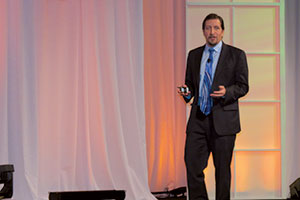Managing Editor, Features and Multimedia
Training Crucial for ELDs, FMCSA Official Says

DALLAS — Driver training on electronic logging devices will play an essential role in helping to smooth the trucking industry’s transition to the federally mandated technology, an official with the Federal Motor Carrier Safety Administration told an audience of carriers and technology providers.
The more drivers know about the ELDs in their trucks, the faster and easier roadside inspections will go, said Joe DeLorenzo, director of FMCSA’s Office of Enforcement and Compliance.
“As you transition to whatever options you choose, I don’t think I can emphasize enough how important that training is,” he said Feb. 2 at Omnitracs’ annual user conference here.
FMCSA’s final rule on ELDs, published Dec. 16, gives carriers two years to comply with the regulation, which will require nearly all interstate truckers to use the devices to record hours of service.
DeLorenzo said device manufacturers can begin registering and certifying their products as compliant ELDs on Feb. 16. FMCSA will maintain a website with a list of certified devices, he said.
He also reminded carriers that the ELD mandate doesn’t change the rules related to hours of service; it changes how those hours are recorded.
As carriers prepare to switch from paper logbooks or the various devices in use today to a consistent standard with ELDs, law enforcement also is making the transition to the new technology, DeLorenzo said.
Under the rule’s technical specifications, ELDs must be capable of transferring data electronically using either e-mail and Web services or a local option using Bluetooth or USB. It also requires either a graphical display or printout option as a backup.
DeLorenzo predicted that the display or printout option will be the default way for law enforcement officers to check hours of service via ELDs during the next two years as the industry moves toward the Dec. 18, 2017, compliance date.
He said that will be the “messiest” phase of the transition because carriers will be able to comply with hours of service through paper logs, electronic logging software, existing devices or newly certified ELDs.
Carriers using existing devices that meet current specifications — known as Automatic Onboard Recording Devices, or AOBRDs — will be able to continue using them an additional two years beyond the compliance date, through Dec. 16, 2019.
A common question about the ELD mandate is how it will affect leasing and rental trucks.
DeLorenzo said FMCSA does not regulate truck leasing and rental companies, but that will not change the requirement that carriers use ELDs to record hours of service.
“The market’s going to have to figure out exactly how that’s going to work,” he said, adding that one solution could be mobile devices that can go in and out of the truck.
Leasing and rental companies also could offer ELD packages for their vehicles to help carriers comply with the rule.
“This is why we have transition time,” DeLorenzo said. “I think it’s something that’s going to get figured out over the next couple years.”
Earlier in the conference, Omnitracs staff outlined steps that fleets could take to help ensure that all recorded driving time is properly assigned.
Kam Roshan, product manager for compliance, said the rule allows yard moves to be recorded as on-duty but not driving time. However, the driver must use the device to indicate the beginning and end of a yard move. Use of the vehicle for personal conveyance is considered off-duty time.
Any back-office edits to a driver’s log must be approved by the driver, Roshan added.
Joe Mirka, principal engineer for Omnitracs, warned that any unassigned vehicle moves could raise a “red flag” for enforcement.
He recommended that fleets create user accounts even for technicians and other staff who move trucks around a yard. If they do not record that time under an account, the driver will have to reconcile that driving time the next time he or she logs in.
“It is best to not raise that red flag, in our opinion, and to make sure that those people have an account as well that they can log into on the ELD,” Mirka said.




